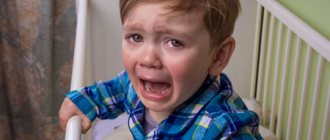Most preschool children can be said to be very active, and in some cases even hyperactive. Kids are easily distracted, quickly lose interest in anything, they are emotional and never sit still. And this is absolutely normal, because perseverance and the ability to self-control at this age are just beginning to form. However, if a child experiences serious and systematic difficulties in controlling his behavior and emotions, this will negatively affect his interactions with adults and peers, as well as the learning process. In this case, most likely, we are talking about hyperactivity as a serious problem that needs to be solved together with specialists (doctors, psychologists, teachers). What is the difference between activity and hyperactivity? What is ADHD? How to deal with a hyperactive child? How can parents help their baby? We will talk about this with you today.
What is the difference between activity and hyperactivity?
A healthy preschool child is an active child. He loves to run, jump, play outdoor games, sing and dance, asks a lot of questions about everything in the world, throws toys around, and so on. How to distinguish a high level of activity from hyperactivity and overexcitability? An active child does not behave this way always and not everywhere. If the baby is interested in something (for example, a book or a game), he can calmly go about his business. In the presence of unfamiliar people or in a new environment, the child is usually not as restless as at home. Excessive activity can also be a consequence of stress, fatigue or boredom, as well as a desire to attract attention, so when the stimulus disappears, the level of activity soon returns to normal.
A hyperactive child, on the contrary, behaves equally actively in all situations: at home, in kindergarten, at a party, and even at a doctor’s appointment. Moreover, obsessive mobility does not have any purpose. Persuasion, requests, punishments and other educational measures do not work on a hyperactive child, since a hyperactive child simply cannot control his behavior.
Hyperactivity is often considered solely as a characteristic of a child’s behavior, but one must understand that external manifestations are a consequence of overexcitation of the baby’s nervous system. Only a doctor can diagnose ADHD.
Diagnostics
If parents suspect that their child has ADHD, they should consult a pediatric neurologist. The doctor will prescribe the appropriate examination that needs to be completed. Indeed, more serious pathologies may be hidden under the symptoms of hyperdynamic syndrome. Diagnostics includes three stages:
- The doctor collects data on the child’s behavior and reactions , the characteristics of pregnancy and childbirth, previous diseases, and hereditary pathologies of family members.
- Conducts special tests and evaluates the results and the amount of time spent, as well as the reaction and behavioral characteristics of the child. Usually such tests are carried out for children 5-6 years old.
- Electroencephalogram . This examination assesses the condition of the child's brain. It is painless and harmless.
After receiving all the results, the neurologist makes a diagnosis and gives his conclusion.
Attention Deficit Hyperactivity Disorder (ADHD)
Attention deficit hyperactivity disorder in children of senior preschool and primary school age is usually considered as a combination of three components: inattention, impulsivity and hyperactivity. A diagnosis can be made if these signs are observed in a child for at least 6 months in a row and interfere with adaptation among peers. Let's look at each of them in more detail.
Inattention:
- The baby cannot maintain attention on small details, so he often makes mistakes when performing various tasks;
- Due to the fact that the child does not concentrate well, he does not always respond to speech addressed to him (including comments);
- Extraneous irritants easily distract the baby even from an interesting activity;
- It is difficult for him to finish what he has started. Sometimes adults get the impression that the child is rebelling because he doesn’t like something, however, the reason is that the child finds it difficult to follow instructions and rules;
- Children often avoid tasks that require long-term concentration;
- Difficulties in planning and organizing your own activities (studies, games, communication, and so on);
- Forgetfulness. Inattentive children often lose their things and forget to do something.
Most often, hyperactivity is combined with attention deficit disorder (ADHD), but there are cases when hyperactive children retain perseverance and the ability to concentrate when performing various tasks.
Hyperactivity:
- The baby is constantly on the move;
- The child does not sit still; while performing a task, he can get up for no reason and do something else;
- Hyperactive children are characterized by fussiness, fidgeting in the chair, obsessive movements of the hands and feet;
- Motor activity (the child is constantly running, trying to climb somewhere, spinning in place) has no purpose;
- Quiet and calm games are not held in high esteem by hyperactive children. They almost never rest and have difficulty sleeping;
- They talk a lot and interrupt other people, constantly asking questions about everything and nothing.
Impulsiveness:
- The child does not listen to the end and gets ahead of himself;
- Waiting is very difficult for him;
- The baby has a hard time learning the rules of communication, interferes in conversations, games, and interferes with other children and adults.
From the first years of life, a hyperactive child can often notice such manifestations as increased muscle tone, spasms when eating, nervous tics, sleep problems, high sensitivity to sounds, light, heat and other external stimuli, an increased pain threshold (insensitivity to pain). ), clumsiness.
Manifestations of hyperactivity, impulsiveness and inattention become most noticeable upon entering kindergarten. During the school years, problems only increase, but by the end of adolescence they usually disappear.
When a child ends up in a kindergarten or school, numerous demands are immediately placed on him: follow the rules and routine of the day, listen to the teacher or educator, sit quietly and answer only when asked. The nervous system of a hyperactive baby has difficulty coping with increased physical and psychological stress. Due to a lack of self-control, he is constantly distracted, does not perceive information well by ear, and as a result, problems with reading, writing and mathematics may arise.
Causes
Experts consider the following situations to be the main reasons that can cause dysfunction of the child’s nervous system, and, consequently, hyperactivity syndrome:
- Heredity (genetic predisposition)
- Damage to brain cells in the prenatal period or during labor.
This may be fetal hypoxia, infections, birth injuries.
- Disorders caused by an unfavorable family environment, abnormal living conditions, improper educational process, illnesses and injuries after birth.
According to statistical data, male children are more likely to suffer from hyperactivity. For every five boys, only one girl is diagnosed with this condition.
Recommendations for parents
If your child has persistent signs of hyperactivity, you should definitely consult a neurologist and psychologist. Specialists will diagnose the physical and mental development of the baby, based on the results of which they will draw up an individual treatment plan and behavior correction. The environment in which an active and hyperactive child usually finds itself greatly influences his behavior, so it is important for parents to adhere to the following principles:
- Create a calm environment at home;
- Do not punish or scold your child for “bad” behavior;
- Follow a daily routine;
- Nutrition should be balanced;
- Give your child the opportunity to splash out accumulated energy (sports, active games while walking);
- Limit your child from watching TV and using gadgets;
- Spend more time outdoors;
- Avoid noisy places and large crowds of people;
- Introduce quiet games and creative activities;
- Give your child specific requests and instructions;
- Teach your child self-organization skills. To do this, you can use various visual materials or reminders (for example, schematic images of actions that a child should perform before bed: brush teeth, wash, put on pajamas, go to bed).
Hyperactive children often face negative attitudes from people who do not understand the functioning of the nervous system and child psychology. That is why such children need special support and acceptance from loved ones.
Solutions
To determine the course of action regarding correction of the child’s behavior, it is important to remember the possible reasons and find specific ones for the individual case. That is, it is not the child who needs to be changed, but his micro- (family) and macro-environment (kindergarten, society), the climate around him (the social situation of development).
First of all, you need to find allies. They mean addressing:
- full-time psychologist;
- teacher (educator);
- defectologist of the institution where the child is studying.
Only together can we ensure work on macro- and microsociety. A child with hyperactivity needs comprehensive psychological, medical, pedagogical (social) support. Many educational institutions currently operate PMPK (psychological-medical-pedagogical councils). If there is such an opportunity, it is better to go there immediately.
It is important to actively work to improve the family. Below are general recommendations for parents on how to interact with a hyperactive child.
- Be consistent, firm and realistic in your demands, rewards and sanctions (phrases like “I don’t know what I’ll do to you” or “I’ll kill you” are absolutely not suitable).
- Remember that your child is special, and not harmful (he does not want to “harm” you).
- Control your child’s actions and do them together.
- Try to avoid rude and unambiguous answers (prohibitions), and explain to your child reasoned why his actions upset you or why he should not behave this way.
- Focus on mutual understanding and trust.
- Be adequate (not to indulge, but also not to demand the impossible).
- Win the child over, surprise, attract his attention (an unexpected joke, copying his behavior).
- Be patient (you need to get used to the idea that you need to repeat your requests often, forget the phrases “how many times can you repeat” and “I won’t repeat to you again.” You will, but in a calm and even tone, and until you are heard ).
- Arouse the child’s interest, reinforce the words with actions, pictures, gestures, and visuals (“Let’s collect toys at speed; whoever wins will get a token on his board. Look how beautiful it is!”).
- Always listen to your child and respond to him.
It is also important to monitor your relationship with your spouse and set a personal example for your child in behavior (screaming can only teach screaming).
It is recommended to create a daily routine. What is important is that it should be common to all family members, and not just to the child. Avoid overwork, overload, noisy places, create a workplace for the child with a minimum of external stimuli.
- When working with a hyperactive child, the system of rewards and punishments plays an important role. It definitely has to be there.
- But it is strictly forbidden to use physical or morally abusive punishments and monetary rewards.
- It is acceptable to enter points and fulfill wishes. Don't be stingy with praise.
- However, at the same time, it is worth considering that hyperactive children respond poorly to beliefs.
- If there is a need for punishment, then it is better to deprive the child of sweets, entertainment, and put him in a corner. But! Clearly say in advance: “I ask you... if you don’t, I will be forced to take your phone away for the day.”
Draw up an “agreement” on the division of responsibilities. To develop self-control, a child must have exclusively his own responsibilities around the house. It is important to take into account the child’s age, developmental characteristics and personal preferences. Everything must be done in cooperation. Help, but don't do the work for him. Simple one-part tasks should be given. It’s better to have several small ones, but in turns.
Use excess activity to your advantage. Find out what abilities your child has and what interests him. For example, you can go swimming.
Please do not confuse control over a child’s actions with total control over his life. Let him gain experience, make mistakes, be late, get bad marks, lose friends (but with your help, of course, get them back).
Games with hyperactive children
- Games for developing attention
- "Catch - don't catch." The most famous game in this category is “Edible - Inedible”. The presenter throws the ball to the child and says the word. If this word means an edible object, the baby must catch the ball, and if it is inedible, then return it. By analogy with this, you can come up with many different games that will be interesting specifically for your child (for example, “Transport is not transport”, “Living - inanimate”, “Dangerous - not dangerous” and so on).
- "Pathfinders". Choose a small toy and hide it in the room, but so that it can be seen. To find the right item, the baby needs to be attentive and not be distracted by other things.
- “Ears on the Top of the Head” is a game aimed at developing auditory attention. Its essence is to hear which of the named words have a certain sound. For example, agree that you will say words, and the child should clap his hands every time he hears the sound “r”.
- Games to develop self-control
- “Freeze.” Turn on dynamic, fun music and invite your baby to dance. As soon as you press pause, the child should freeze in place.
- "Wait for the signal." This is a word conversation game. Its essence lies in the fact that the adult asks the baby various questions, and the child can begin to answer them only after a certain signal (for example, when you touch your ear with your hand or fold your arms over your chest).
- “I’m silent - I whisper - I scream.” The child’s task in this game is to perform all actions, focusing on the sign that the adult shows him. Agree with the baby on the conventions: for example, a sleep gesture - the baby should be silent and not move, a finger at the lips - speak quietly and move slowly, hands up - you can scream, run and jump.
- Games to relieve emotional and muscle tension
- “We draw with our fingers.” Ask your child to take a relaxed position and close their eyes. On his back or palm you can “draw” various figures, numbers, letters and other schematic images with your finger. The child must guess what you drew.
- "The wind is a breeze." Together with your baby, draw a strong wind and a weak breeze with your hands. This can be done to classical music, depending on its tempo.
- "Soap bubble". In this game, the adult pretends to be blowing a soap bubble, and the child “flies” around the room like a bubble. After the command “burst”, the baby must lie on the floor.
What to do when you are hysterical?
If a hyperactive child has a tantrum and he stops hearing those around him, parents can simply go to another room. Then the baby, having lost his existing audience, will gradually calm down.
You can try to switch your child's attention to an interesting cartoon or a new toy. It’s a good idea to invite him to play an active game, for example, tag. It is also useful for your baby to make soothing tea or warm sweet water.
In order to subsequently avoid the hysterical state of your own child, you need to strengthen his nervous system. To do this, it is useful to take baths with the addition of valerian herb.
conclusions
Many children of preschool and primary school age look too active in the eyes of adults. They are constantly on the move, love active games, and cannot sit still. And this is normal, because an active baby is a healthy child. But some children do not become calmer even in an unfamiliar environment; their activity is intrusive, it prevents them from learning information and adapting to a peer group. The nervous system of hyperactive children is too excitable and has difficulty coping with a large number of stimuli, resulting in inattention, impulsiveness, and an inability to control behavior. To help a hyperactive child cope with difficulties, you need to develop a special educational approach to the child, accept him as he is, and not scold him for “bad” behavior. A favorable home environment, daily routine, sports, special games and other important things are what parents can use for the benefit of their baby.
Hyperactivity in preschool children
Try not to send your restless child to school at the age of six. After all, it will be very difficult for him to concentrate on lessons. Let it be like kindergarten classes at first. Just ask the teacher in advance not to tie him to one place, let him sit where he is comfortable, move, play, jump.
Although it very often happens that a child begins to be rude to teachers and does not find a common language with the children. In such cases, it is better for parents to change groups or even kindergartens. So as not to make the situation worse. Unfortunately, not all educators are able to find a certain approach to such children.










